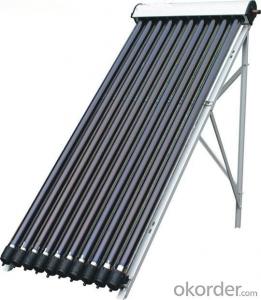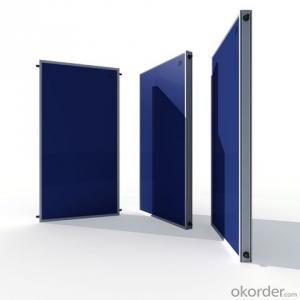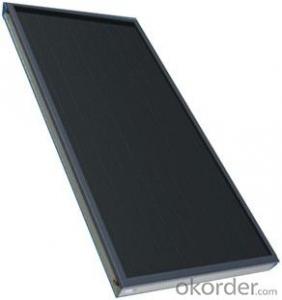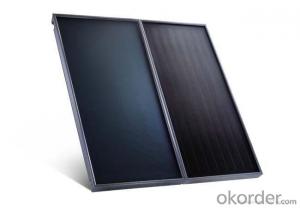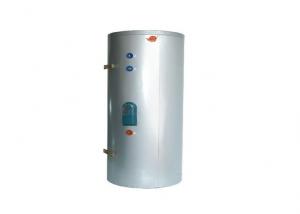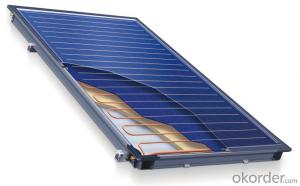Heat-pipes Solar Collectors for Rooftop with ROHS Certificate
- Loading Port:
- China main port
- Payment Terms:
- TT OR LC
- Min Order Qty:
- 5 set
- Supply Capability:
- 10000 set/month
OKorder Service Pledge
OKorder Financial Service
You Might Also Like
Specifications
manifold (inner) | red copper |
manifold (exterior) | aluminum alloy |
glass tube dimensions | 58mm * 1800mm |
daily efficiency | ≥55% |
heat preservation | 72 hours |
hail resistance | 25mm |
max pressure | 7 bar |
coating of vacuum tube | ALN/AIN-SS/CU |
heat pipe | anti-freezing > -35 degree |
certificate | Solar Keymark, EN12975,SRCC |
Serious Product
Models | L*W*H mm | Vacuum tube | Power output | Efficiency | Header mm | Frame | container loading 20FT/40HQ sets | Gross Weight kg |
SHC-8 | 1917*910*133 | 58*1800*8pcs | 939W | 0.668 | Φ35/1.0 | AL alloy | 185/445 | 27 |
SHC-10 | 1917*1130*133 | 58*1800*10pcs | 1189W | 159/385 | 33 | |||
SHC-12 | 1917*1350*133 | 58*1800*12pcs | 1440W | 149/358 | 40 | |||
SHC-15 | 1917*1680*133 | 58*1800*15pcs | 1815W | 120/290 | 49 | |||
SHC-18 | 1917*2010*133 | 58*1800*18pcs | 2191W | 100/242 | 59 | |||
SHC-20 | 1917*2230*133 | 58*1800*20pcs | 2442W | 87/210 | 66 | |||
SHC-22 | 1917*2450*133 | 58*1800*22pcs | 2692W | 83/202 | 72 | |||
SHC-24 | 1917*2670*133 | 58*1800*24pcs | 2943W | 77/188 | 79 |
Packaging & Delivery
Packaging Details: | Exporting Carton with big foaming protection |
Delivery Detail: | In 10-15 days |
Loading Quantity
Model | Tube | Tube Q.T.Y | Loading Q.T.Y/40HQ |
GSC15 | 58*1800mm | 15pcs | 315sets |
GSC18 | 58*1800mm | 18pcs | 265sets |
GSC20 | 58*1800mm | 20pcs | 248sets |
GSC22 | 58*1800mm | 22pcs | 225sets |
GSC25 | 58*1800mm | 25pcs | 200sets |
GSC30 | 58*1800mm | 30pcs | 168sets |
Principle of solar collector:
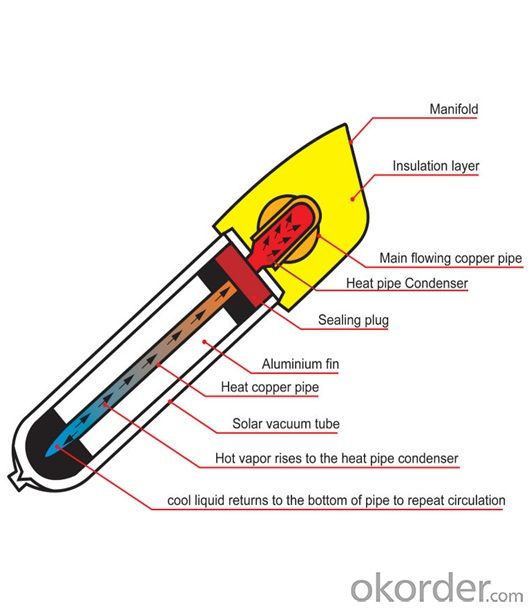

Solar collector details
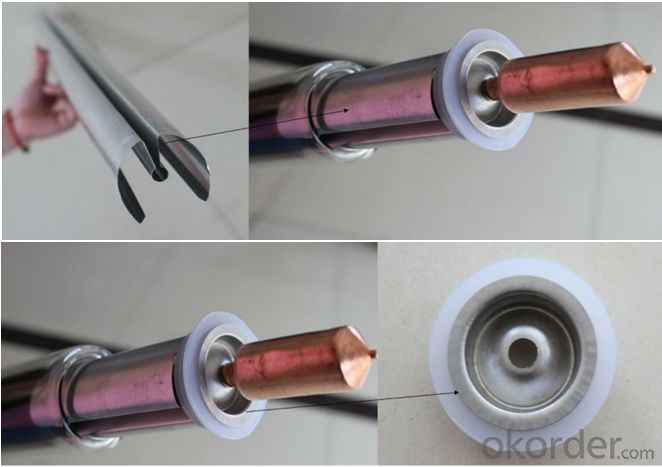

- Q:Can solar collectors be used for heating casinos?
- Yes, solar collectors can certainly be used for heating casinos. Solar thermal technology can be employed to capture and convert sunlight into heat energy, which can then be used for various heating applications within the casino, such as space heating or water heating. This can help reduce reliance on fossil fuel-based heating systems and contribute to the overall sustainability and energy efficiency of the casino.
- Q:Can solar collectors be used for heating military installations?
- Yes, solar collectors can be used for heating military installations. Solar thermal systems can provide reliable and sustainable heat for various purposes, including heating buildings, water, and even assisting in space heating during colder climates. By harnessing solar energy, military installations can reduce their dependence on fossil fuels, lower operational costs, and contribute to a greener and more resilient energy infrastructure.
- Q:Can solar collectors be used for heating green roofs?
- Yes, solar collectors can be used for heating green roofs. Solar collectors can capture and convert sunlight into heat energy, which can then be used to warm the green roof's soil or irrigation system. This can help to extend the growing season, increase plant productivity, and promote overall health of the green roof ecosystem.
- Q:What is the average payback period for a solar collector installation?
- The payback period for a solar collector installation can differ based on several factors, like the system's size and type, location, local energy prices, and available incentives. Typically, it ranges from 5 to 15 years. The payback period represents the time required to recover the installation's cost through energy savings. Solar collector installations are renowned for their long-term financial advantages, as they significantly reduce or even eliminate electricity bills by utilizing renewable solar energy. Various factors can reduce the payback period, including beneficial local policies and incentives like tax credits or rebates, high electricity prices, and abundant sunlight. Furthermore, technological advancements have resulted in more efficient and affordable solar collectors, further shortening the payback period. It is crucial to note that although the initial investment for a solar collector installation may be higher compared to traditional energy sources, the long-term savings and environmental benefits justify it as a worthwhile investment. Additionally, as the cost of solar technology continues to decline and energy prices increase, the average payback period is expected to decrease, making solar collector installations even more financially viable in the future.
- Q:How much space is required for a solar collector installation?
- The space required for a solar collector installation can vary depending on the size and type of the collector system. Generally, a typical residential solar collector installation can require around 100 to 400 square feet of roof space, while larger commercial or industrial installations may require several thousand square feet of land or roof space. It is important to consult with a solar professional to determine the specific space requirements for a particular installation.
- Q:Can solar collectors be used in agricultural applications?
- Yes, solar collectors can be used in agricultural applications. They can be utilized to power irrigation systems, greenhouse heating, and drying crops, among other agricultural processes. Solar energy provides a sustainable and cost-effective solution for farmers, helping to reduce dependence on traditional energy sources and lower operational costs.
- Q:Can solar collectors be used in residential areas?
- Residential areas can definitely make use of solar collectors. In fact, these devices are being adopted more and more in neighborhoods across the globe. Solar collectors, also known as solar panels or photovoltaic (PV) systems, are specifically designed to convert sunlight into usable electricity. They can be mounted on rooftops, walls, or even stand alone in open spaces found within residential properties. The utilization of solar collectors in residential areas offers a multitude of advantages. Firstly, they provide a clean and renewable energy source, reducing dependence on fossil fuels and contributing to a greener and more sustainable future. Solar energy is abundant and readily accessible, making it an ideal choice for residential areas. Secondly, solar collectors have the potential to substantially reduce homeowners' electricity bills. By generating electricity on-site, residents can offset their energy consumption from the grid, leading to significant cost savings over time. In some instances, excess energy produced by solar collectors can even be sold back to the grid through net metering programs, further lowering electricity costs. Moreover, solar collectors require minimal upkeep and boast a long lifespan, typically lasting 25 to 30 years or more. This makes them a reliable and cost-effective investment for homeowners. Additionally, many governments and local authorities offer incentives and tax credits to encourage the adoption of solar power in residential areas, making the initial installation costs more affordable. Although there may be some concerns regarding aesthetics, modern solar collectors are designed to seamlessly blend with residential architecture. Numerous options are available to cater to different styles and preferences. Furthermore, advancements in technology have increased the efficiency and compactness of solar collectors, allowing for greater flexibility in installation. In conclusion, solar collectors are a practical and feasible choice for residential areas. They provide clean and renewable energy, reduce electricity bills, require minimal maintenance, and have long lifespans. With the growing emphasis on sustainability and the availability of government incentives, it is no surprise that solar collectors are gaining popularity in residential neighborhoods worldwide.
- Q:How do solar collectors impact energy security?
- Diversifying and decentralizing energy production, solar collectors significantly impact energy security. Unlike traditional energy sources like fossil fuels, which are often imported and susceptible to geopolitical tensions and supply disruptions, solar collectors harness the abundant and renewable energy from the sun, reducing reliance on external sources. The installation of solar collectors on rooftops, homes, and buildings enables individuals and communities to generate their own electricity, enhancing energy security by reducing dependence on centralized power plants and vulnerability to power outages. Even in the face of natural disasters or grid failures, solar collectors can continue producing electricity, ensuring a reliable and uninterrupted power supply. Furthermore, solar collectors contribute to energy security by reducing greenhouse gas emissions and mitigating climate change. As the world transitions to a low-carbon economy, the reliance on fossil fuels decreases, enhancing energy security by reducing the impact of volatile oil prices and geopolitical tensions associated with fossil fuel extraction and transportation. Solar collectors also promote energy independence and resilience. By producing clean energy locally, communities can reduce their reliance on external energy sources and strengthen their energy self-sufficiency. This not only enhances energy security but also fosters economic growth and job creation in the renewable energy sector. Additionally, solar collectors can be integrated with energy storage technologies, such as batteries, to store excess electricity generated during the day for use during the night or periods of low sunlight. This further enhances energy security by providing a reliable and dispatchable source of electricity, reducing dependence on the grid and increasing resilience in the face of power disruptions. In conclusion, solar collectors have a positive impact on energy security by diversifying energy sources, reducing dependence on imported fossil fuels, promoting energy independence, and enhancing resilience against power outages and climate-related events. By harnessing the power of the sun, solar collectors contribute to a more secure and sustainable energy future.
- Q:Are there any corrosion concerns with solar collectors?
- Yes, corrosion can be a concern with solar collectors, especially if they are exposed to certain environmental conditions or if improper materials are used in their construction. It is important to select corrosion-resistant materials and regularly inspect and maintain the collectors to prevent any potential damage or efficiency loss due to corrosion.
- Q:Can solar collectors be used in areas with limited access to government assistance?
- Yes, solar collectors can be used in areas with limited access to government assistance. Solar energy is a renewable resource that can be harnessed independently of government programs or subsidies. With the right infrastructure and technology, solar collectors can provide a reliable source of electricity and heating in areas with limited government support, helping to reduce dependence on traditional energy sources and improve energy access in remote or underserved communities.
1. Manufacturer Overview |
|
|---|---|
| Location | |
| Year Established | |
| Annual Output Value | |
| Main Markets | |
| Company Certifications | |
2. Manufacturer Certificates |
|
|---|---|
| a) Certification Name | |
| Range | |
| Reference | |
| Validity Period | |
3. Manufacturer Capability |
|
|---|---|
| a)Trade Capacity | |
| Nearest Port | |
| Export Percentage | |
| No.of Employees in Trade Department | |
| Language Spoken: | |
| b)Factory Information | |
| Factory Size: | |
| No. of Production Lines | |
| Contract Manufacturing | |
| Product Price Range | |
Send your message to us
Heat-pipes Solar Collectors for Rooftop with ROHS Certificate
- Loading Port:
- China main port
- Payment Terms:
- TT OR LC
- Min Order Qty:
- 5 set
- Supply Capability:
- 10000 set/month
OKorder Service Pledge
OKorder Financial Service
Similar products
New products
Hot products
Hot Searches
Related keywords
